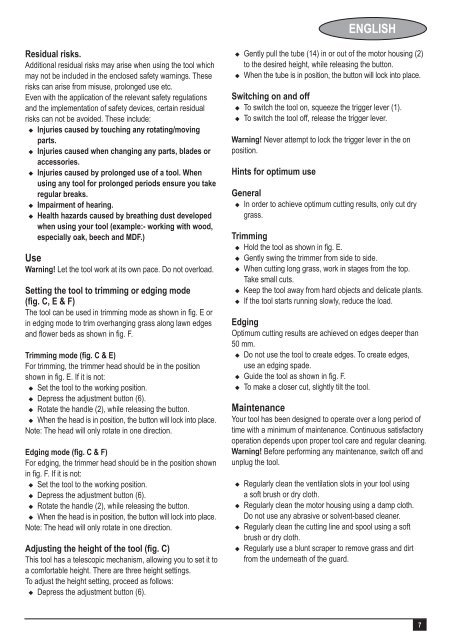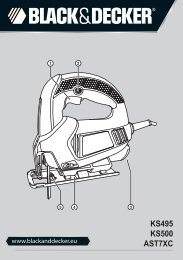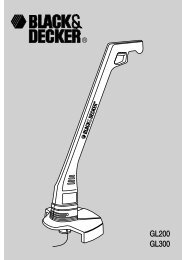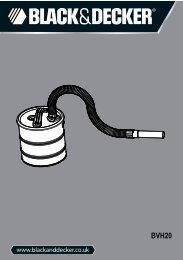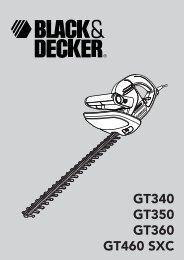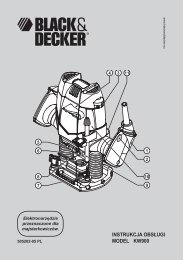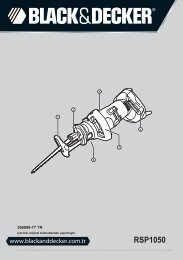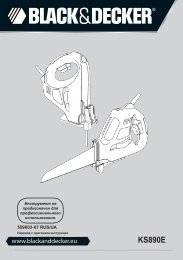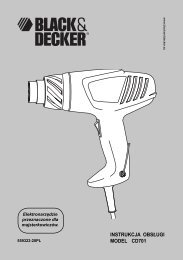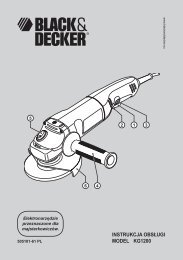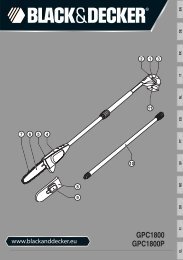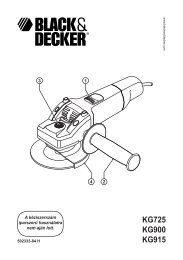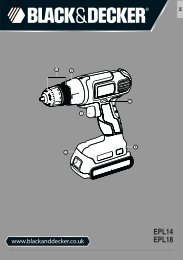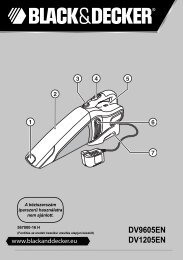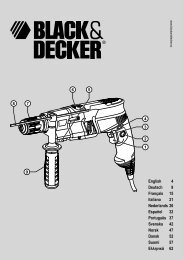Create successful ePaper yourself
Turn your PDF publications into a flip-book with our unique Google optimized e-Paper software.
Residual risks.<br />
Additional residual risks may arise when using the tool which<br />
may not be included in the enclosed safety warnings. These<br />
risks can arise from misuse, prolonged use etc.<br />
Even with the application of the relevant safety regulations<br />
and the implementation of safety devices, certain residual<br />
risks can not be avoided. These include:<br />
u Injuries caused by touching any rotating/moving<br />
parts.<br />
u Injuries caused when changing any parts, blades or<br />
accessories.<br />
u Injuries caused by prolonged use of a tool. When<br />
using any tool for prolonged periods ensure you take<br />
regular breaks.<br />
u Impairment of hearing.<br />
u Health hazards caused by breathing dust developed<br />
when using your tool (example:- working with wood,<br />
especially oak, beech and MDF.)<br />
Use<br />
Warning! Let the tool work at its own pace. Do not overload.<br />
Setting the tool to trimming or edging mode<br />
(fig. C, E & F)<br />
The tool can be used in trimming mode as shown in fig. E or<br />
in edging mode to trim overhanging grass along lawn edges<br />
and flower beds as shown in fig. F.<br />
Trimming mode (fig. C & E)<br />
For trimming, the trimmer head should be in the position<br />
shown in fig. E. If it is not:<br />
u Set the tool to the working position.<br />
u Depress the adjustment button (6).<br />
u Rotate the handle (2), while releasing the button.<br />
u When the head is in position, the button will lock into place.<br />
Note: The head will only rotate in one direction.<br />
Edging mode (fig. C & F)<br />
For edging, the trimmer head should be in the position shown<br />
in fig. F. If it is not:<br />
u Set the tool to the working position.<br />
u Depress the adjustment button (6).<br />
u Rotate the handle (2), while releasing the button.<br />
u When the head is in position, the button will lock into place.<br />
Note: The head will only rotate in one direction.<br />
Adjusting the height of the tool (fig. C)<br />
This tool has a telescopic mechanism, allowing you to set it to<br />
a comfortable height. There are three height settings.<br />
To adjust the height setting, proceed as follows:<br />
u Depress the adjustment button (6).<br />
ENGLISH<br />
u Gently pull the tube (14) in or out of the motor housing (2)<br />
to the desired height, while releasing the button.<br />
u When the tube is in position, the button will lock into place.<br />
Switching on and off<br />
u To switch the tool on, squeeze the trigger lever (1).<br />
u To switch the tool off, release the trigger lever.<br />
Warning! Never attempt to lock the trigger lever in the on<br />
position.<br />
Hints for optimum use<br />
General<br />
u In order to achieve optimum cutting results, only cut dry<br />
grass.<br />
Trimming<br />
u Hold the tool as shown in fig. E.<br />
u Gently swing the trimmer from side to side.<br />
u When cutting long grass, work in stages from the top.<br />
Take small cuts.<br />
u Keep the tool away from hard objects and delicate plants.<br />
u If the tool starts running slowly, reduce the load.<br />
Edging<br />
Optimum cutting results are achieved on edges deeper than<br />
50 mm.<br />
u Do not use the tool to create edges. To create edges,<br />
use an edging spade.<br />
u Guide the tool as shown in fig. F.<br />
u To make a closer cut, slightly tilt the tool.<br />
Maintenance<br />
Your tool has been designed to operate over a long period of<br />
time with a minimum of maintenance. Continuous satisfactory<br />
operation depends upon proper tool care and regular cleaning.<br />
Warning! Before performing any maintenance, switch off and<br />
unplug the tool.<br />
u Regularly clean the ventilation slots in your tool using<br />
a soft brush or dry cloth.<br />
u Regularly clean the motor housing using a damp cloth.<br />
Do not use any abrasive or solvent-based cleaner.<br />
u Regularly clean the cutting line and spool using a soft<br />
brush or dry cloth.<br />
u Regularly use a blunt scraper to remove grass and dirt<br />
from the underneath of the guard.<br />
7


